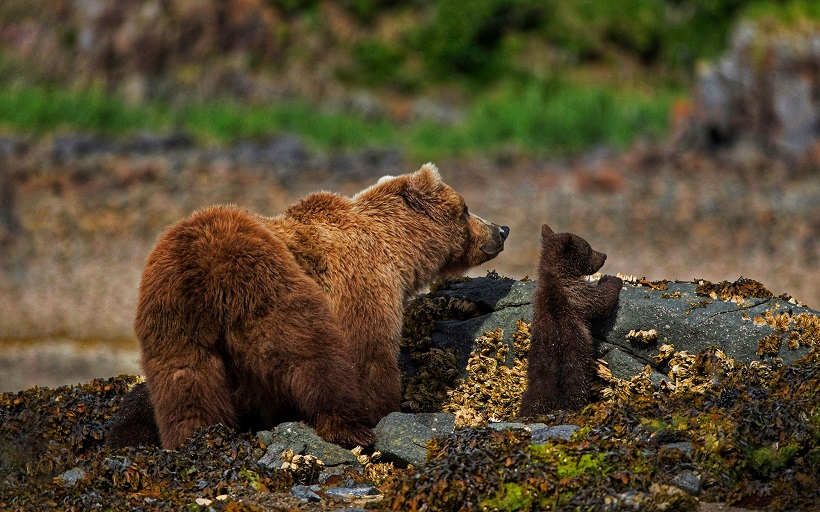
At a time when a man-eater is being hunted for preying on three children in Kashmir, the new wild sightings have ended an officially-declared disappearance of a bear now haunting humans in their own habitats.
By Sajid Raina
NAZIR Ahmad is back on wild duty following the rare bear-sightings in the rumbling woods of Bandipora.
The 52-year-old wildlife watchman wears a cow-boy hat, hawkish gaze and swift body language while patrolling the jungle he describes “viciously wild”.
In a hot summer day of June 2022, the forest guard endlessly talks about the new glimpses being termed as a game-changer for the jungle and its adjacent areas.
“This species was declared endangered, but its growing population has now become an alarming sign for humans in their own backyards,” says Nazir, confirming presence of brown bears in north Kashmir’s Bandipora district.
Spotting of rare Himalayan endangered brown bears in parts of Kashmir has prompted wildlife experts to blame the rapid development and increased tourism activities in high altitudes.
Earlier, the animal was protected under Schedule I of the Wildlife (Protection) Act, 1972, following existential crisis posed due to rapid habitat loss, human-animal conflict and poaching.
In sub-continent, the species is distributed in Pakistan, Muzaffarabad, Uttarakhand, Himachal Pradesh and Jammu and Kashmir.
Scanning the green gold with gritty gestures, Nazir calls the brown bear as the “biggest animal” in Kashmir.
“An adult weighs more than 2.5 quintals,” he pauses to make his point. “It’s found at an altitude of 2,000 to 2,500 metres, mostly above the tree line.”
Brown bear population, the experts argue, was almost non-existent in residential areas of Kashmir, before it kicked a strong comeback in the last three-decades.
In fact, in the last two to three years, wildlife conservationists have noted increasing sightings and spread of this animal in the hills of Sonamarg, Drass and now in Gurez area of Bandipora district.
“Only in 2014,” Nazir continues, “we caught one such animal in Arin area of Bandipora district. Evidence of their presence in residential area is now emerging because some videos of Gurez have gone viral in which it is being seen.”
Last month, the similar brown bear was suddenly spotted in Shahgund village of Bandipora which surprised the wildlife officials and the locals. The animal was eventually caught after four darts were shot to sedate it.
Weeks after Shahgund, several critically-endangered Himalayan brown bears were sighted in the hinterlands of Bandipora.
Rattled residents said that these animals were seen in Khandyal village while another similar bear was spotted crossing the Kishanganga dam site.
Some elders of the area have also admitted that they’ve “never seen such animals before”.
Last year, two such bears were sighted in Dumail area of Baltal near Amarnath cave shrine, besides three were seen in Drass sector of Ladakh region.
“In Kargil range, the animal was rarely spotted before,” says Aaliya Mir of Wildlife SOS. “But now, it’s being seen in lower vicinities due to massive construction, increased military footfall, nomad footprint and trekking destinations.”
People throw garbage out of their homes which, Aaliya says, is also a reason for brown bears to come down from high altitude.
“These wild animals have started relying on trash and food waste generated by humans at campsites, hotels, and restaurants for sustenance,” she says.
“There have also been frequent sightings of the animal in the cropland, market places and military installations. Their sudden presence in Gurez has to do with construction and tourist infrastructure works there.”
During his jungle jaunt, Nazir halts at a secluded spot imprinted with some stark footmarks of a brown bear.
“They’re now migrating, like never before, from the higher reaches to the residential areas because of human interference in their habitat,” the wildlife official says.
“It’s a clear sign and statement of what goes around, comes out.”
Follow this link to join our WhatsApp group: Join Now
Be Part of Quality Journalism |
Quality journalism takes a lot of time, money and hard work to produce and despite all the hardships we still do it. Our reporters and editors are working overtime in Kashmir and beyond to cover what you care about, break big stories, and expose injustices that can change lives. Today more people are reading Kashmir Observer than ever, but only a handful are paying while advertising revenues are falling fast. |
| ACT NOW |
| MONTHLY | Rs 100 | |
| YEARLY | Rs 1000 | |
| LIFETIME | Rs 10000 | |













